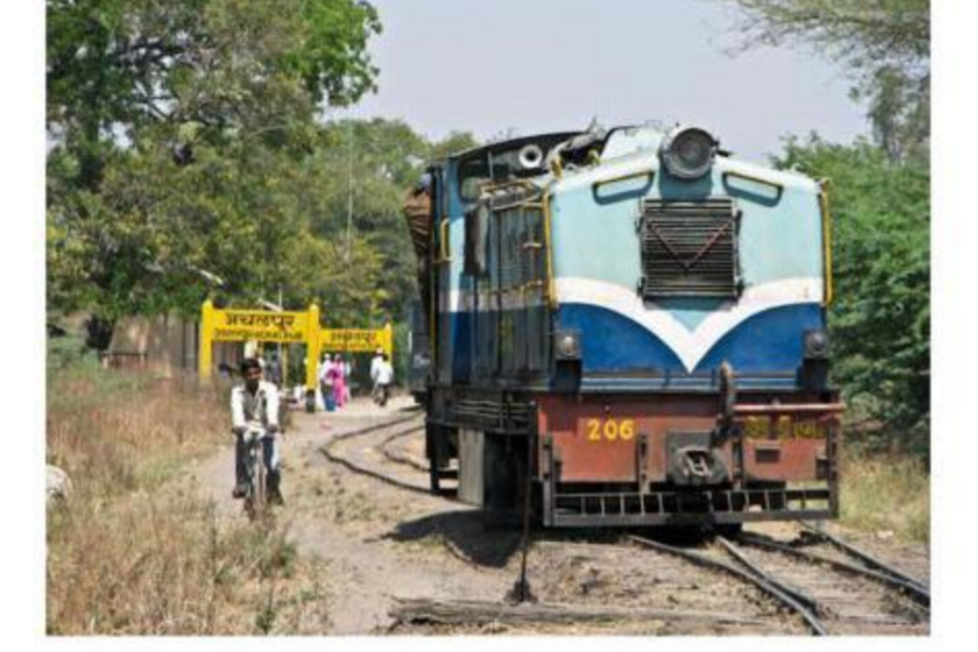British still Own this railway track in India!


Do you know Britain still owns railway track in India ?
That there is still a small hold of British Raj in the Indian Railways? All of the Indian Railways got nationalised in the year 1951 except the narrow gauge line of Shakuntala Railways. (forgotten?)
The railway, which is named after the queen of Vidarbha, still runs on a narrow guage railway network.
Highlights
· Central Province Railway opened this narrow gauge line, Shakuntala Railway, in 1910, which is owned by a British firm Killick-Nixon
· The company built this line mainly for the shipment of cotton from Yavatmal to Mumbai
· Earlier, it was run by a ZD-steam engine marked ‘made in Liverpool’ which was put in service in 1923. Presently, this passenger train is run by a diesel engine
· The railway network named after the queen of Vidarbha, the eastern part of Maharashtra that comprises of Nagpur division and Amravati division
· This narrow guage line originates from Mumbai-Nagpur-Calcutta broad gauge line (Murtizapur junction, Kolkata)
· The British company still charges more than a Crore per year from Indian Railways for running a train on these tracks (to be exact 1.2 Crores per year)
· The train travels 190 km in about four hours. It is the cheapest mode of transport for the people of Amravati district which costs around Rs 25 for a single trip
· The journey gives you the pleasure of beautiful scenic beauty of country side as the train passes through beautiful hills and plateaus
· The train is the lifeline for the people of Yavatmal and Achalpur (Amravati district) of Maharashtra
Amravati, Maharashtra: Killick Nixon and Company, a British-owned company still gets an annual royalty of Rs 1.20 crore from the Indian Railways for running a passenger train known as the Shakuntala Express on its narrow gauge route.
Shakuntala Express runs in the remote cotton-growing area of Achalpur (formerly Ellichpur) under Amravati division, the birthplace of President Pratibha Patil.
The four hour, 189km trip from the towns of Yavatmal to Murtijapur costed Rs 22 several years back.The tracks are still owned by the British company that laid them in the nineteenth century.
It’s like chugging a century back into the Edwardian era of the British Raj. The Shakuntala Express does just one return journey a day. That is all its operators, the Central Railways, can afford.
It is the only transport link for many desperately poor people from the far-flung hamlets of this region.
The non-descript station, occupying a wasteland of now-abandoned goods-yards on the outskirts of this cotton town, comes alive to the petulant noise of Shakuntala as she comes to a halt, bringing commuters of all creeds to their destination, most of them poor and ticketless.
A staff of seven carry out all the railway tasks by hand, from detaching the engine from the carriages, to signalling and ticket sales.
The line from Yavatmal climbs down a long curving embankment before heading for Murtazapur through dry farmlands, intermittent plantations of eucalyptus trees and patches of forestland.
The signals and the loop’s outer point are still worked by a century-old lever-frame, a solid piece of ironmongery bearing the inscription Railway Signal Co Ltd, Liverpool, England 1895.
Killick, Nixon and Company, set up in 1857, created the Central Provinces Railway Company (CPRC) to act as its agents. The company built this narrow gauge line in 1903 to carry cotton from Yavatmal to the main line to Mumbai from where it was shipped to Manchester in England.
A ZD-steam engine, built in 1921 in Manchester, pulled the train for more than 70 long years after being put in service in 1923. It was withdrawn on April 15, 1994, and replaced by a diesel engine that now pulls the carriages.
The steam locomotive now rests in a shed in Pune, in north-western Maharashtra.
“Authorities might have removed the steam engine because of water scarcity in this region,” Hasan Khan, the train’s assistant driver says.
This is one of only a few operational railway lines in India that remains with private owners and perhaps the only one that belongs to a British firm.
The Indian government reviews the question of purchase of these lines every 10 years. But taking over these loss-making lines would require a heavy capital investment to upgrade them.
It was rumoured that the line would close when Indian Railways’ contract to operate the line ended in 2006, but it was extended again for 10 years.
The historic town of Achalpur (Ellichpur) is 291.29 km away from Nagpur. The commercial importance of this station can be judged from the fact that an average of five wagons are booked from this station daily.
The outward goods traffic consists of cotton which is exported to Bombay, Kanpur and Shalimar; cotton-seed to New Delhi and Bombay; dry chillis to Shalimar, Gaya, Allahabad and Bombay.
There is also brisk export of timber, rafters and bailies. Sizeable parcels of handloom cloth, rosha oil, coffee-seeds, mangoes, guavas and oranges are exported from Ellichpur.
DISCLAIMER: The author is solely responsible for the views expressed in this article. The author carries the responsibility for citing and/or licensing of images utilized within the text.
